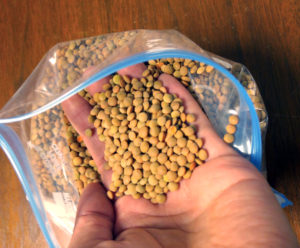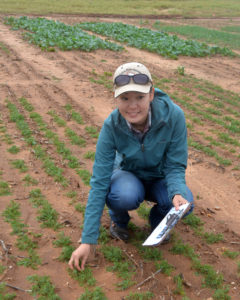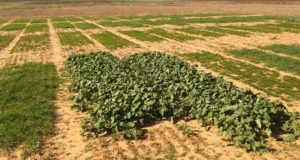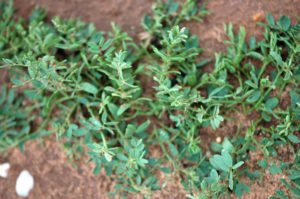Just as lentils add variety to a soup, Dr. Emi Kimura believes they could add variety to the crop options for wheat producers in the Rolling Plains.
 Lentils may be a potential winter crop for the Rolling Plains of Texas. (Texas A&M AgriLife photo by Dr. Emi Kimura)
Lentils may be a potential winter crop for the Rolling Plains of Texas. (Texas A&M AgriLife photo by Dr. Emi Kimura)Lentils are legumes that grow in pods on a bushy plant, and as a legume, they are high in nitrogen, which would be beneficial for the following wheat crop, Kimura, a Texas A&M AgriLife Extension Service agronomist in Vernon, said.
“In the Rolling Plains of Texas, our crop options are limited because of rainfall,” she said. “Our average is 25 inches of annual precipitation, but that is not spread out through the growing season. Primarily it comes in the spring and fall, so during the summer growing season, we really don’t have enough moisture. We have to concentrate on drought-tolerant crops.”
Currently, she said, the crop options for fall planting are limited to canola. Canola has done very well, improving soil tilth for the following wheat production.
 Dr. Emi Kimura, Texas A&M AgriLife Extension Service agronomist in Vernon, checks out her lentil comparison trial near Chillicothe. (Texas A&M AgriLife photo by Kay Ledbetter)
Dr. Emi Kimura, Texas A&M AgriLife Extension Service agronomist in Vernon, checks out her lentil comparison trial near Chillicothe. (Texas A&M AgriLife photo by Kay Ledbetter)“But it would be nice to have an additional crop rotation option to not only improve soil health, but to also improve wheat production,” Kimura said. “Lentil is a grain legume that can improve overall fertility in the soil through nitrogen fixation as well as allow grassy weed control and break disease cycles.”
Lentils are also known to be very tolerant to the extreme environmental conditions such as high temperatures and low limited moisture conditions, she said.
“If we get too much stress during the flowering or fruit set, that might reduce the yield potential, but it is still a strong drought-tolerant crop that can be planted as a winter crop,” Kimura said.
In the U.S., the lentil crop is generally planted in the Pacific Northwest in Washington and Idaho and is planted in the spring, she said. However, there have been considerable studies to improve the winter hardiness of lentils so they can be planted in the fall as winter lentils.
“I believe winter lentils will work better than spring lentils because our summer precipitation is so low and summer heat might be too high,” Kimura said.
 A trial comparing, from left to right, wheat, canola and lentils is being conducted by Dr. Emi Kimura near Chillicothe. (Texas A&M AgriLife photo by Dr. Emi Kimura)
A trial comparing, from left to right, wheat, canola and lentils is being conducted by Dr. Emi Kimura near Chillicothe. (Texas A&M AgriLife photo by Dr. Emi Kimura)“I planted a variety called Morton winter lentil on Sept. 30 at the AgriLife Research station at Chillicothe, along with winter wheat and canola, just to compare the rotation options. Next year I will come back and plant winter wheat after the winter lentil to investigate how it positively or negatively affects the winter wheat.”
Beyond this initial study, Kimura said more studies will need to be done on seeding rate, variety, timing, and weed and insect control.
 Winter lentils are being tested in the Rolling Plains climate. (Texas A&M AgriLife photo by Kay Ledbetter)
Winter lentils are being tested in the Rolling Plains climate. (Texas A&M AgriLife photo by Kay Ledbetter)Some other considerations will be eventual marketing, but first has to come the testing to see if it will grow here, she said. It is planted with the same drill as canola or winter wheat, but harvesting could be slightly different. Several methods need to be tested, but it might be similar to canola. The lentil harvest would be after wheat and canola.
Kimura said she is not sure if lentils lend themselves to grazing or harvesting for forage prior to harvest of the grain. She is testing if the forage can be harvested this fall because as a legume it would have a higher forage quality than just a grass.
“If we can make it work, we can improve crop diversity or available crop options for Rolling Plains’ wheat producers, but also we can contribute to improved diversification of available protein sources for Texas,” she said.